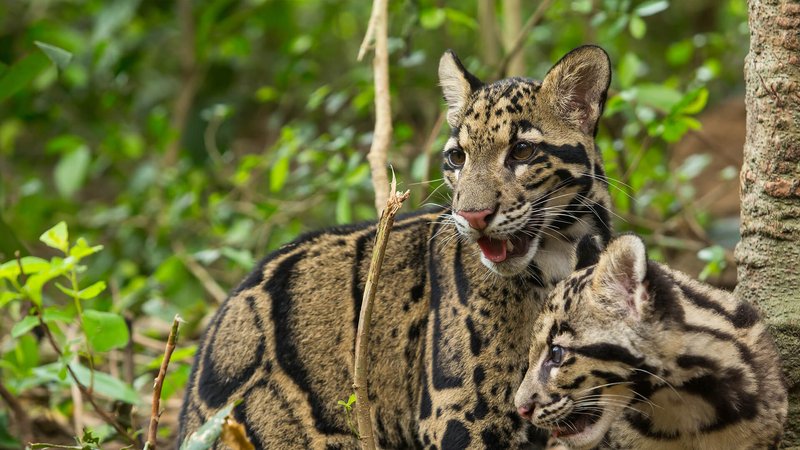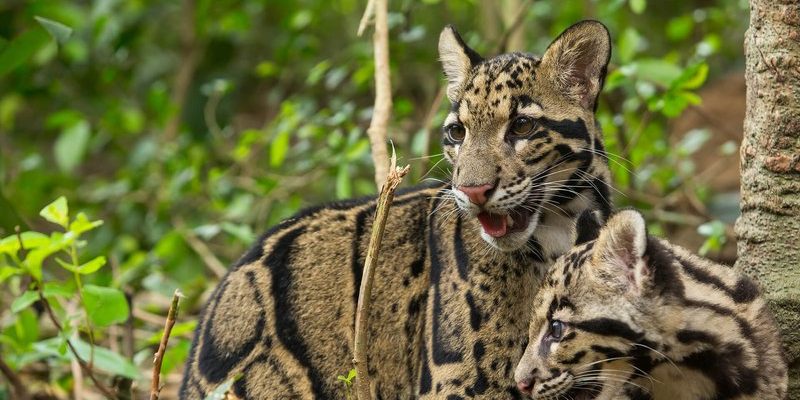
The clouded leopard, a captivating creature native to the dense forests of Southeast Asia, is often overshadowed by its larger relatives, yet it possesses traits that make it uniquely fascinating. Picture this: a sleek feline with a stunning coat covered in large, cloud-like patches, blending effortlessly into its lush surroundings. When you see one of these magnificent animals in action, it’s like watching an acrobat perform in the trees, combining grace with a hint of wild mystery.
But there’s more to the clouded leopard than just its striking appearance. These cats are masters of stealth and agility, using their skills to navigate both the ground and the treetops with ease. Their elusive nature means that spotting one in the wild is rare, adding to their allure. In this article, we’ll explore everything there is to know about the clouded leopard, from its physical traits and habitat to its behavior and conservation status. Get comfy, and let’s dive in!
Physical Characteristics
The clouded leopard is a medium-sized big cat, with adults weighing between 50 to 80 pounds. One of the most notable features of the clouded leopard is its stunning coat, which can range in color from a pale yellow to a rich chocolate brown. The large, irregularly shaped spots, resembling clouds, help the cat blend into its forest environment, providing excellent camouflage from predators and prey alike.
Another remarkable aspect of their appearance is their long tails, which can be as long as their bodies. This tail acts almost like a tightrope walker’s balancing pole, helping them navigate branches high above the ground with remarkable precision. Their unique anatomy includes large canines and sharp claws that are retractable, allowing them to be stealthy hunters. Since they’re adapted to their forest homes, their long legs and flexible bodies enable them to pounce and climb efficiently.
Habitat and Range
Clouded leopards inhabit tropical and subtropical rainforests, but they can also be found in scrub forests and grasslands. Their range extends across several countries in Southeast Asia, including Malaysia, Thailand, Vietnam, and parts of China and Burma. These cats are arboreal, which means they spend a lot of their time in trees, where they feel safe and can easily stalk their prey.
The clouded leopard’s specific habitat preferences often center around dense, humid areas that provide ample cover and climbing opportunities. They are known to favor hilly or mountainous terrains, where they can move between the trees and the ground seamlessly. Unfortunately, habitat destruction due to logging, agriculture, and urban expansion poses a significant threat to their survival.
| Characteristic | Description |
| Size | Medium-sized; weighs 50-80 pounds |
| Habitat | Tropical and subtropical rainforests |
| Diet | Primarily mammals, birds, and reptiles |
| Speed | Can reach speeds up to 30 mph |
| Lifespan | 10-15 years in the wild |
Diet and Hunting Behavior
Clouded leopards are carnivorous and have a diverse diet, hunting a variety of prey, including monkeys, deer, birds, and smaller mammals. Their diet can vary significantly based on their habitat and available resources. An interesting fact to note is that they are skilled at climbing and often hunt from trees, using their keen eyesight to spot prey below.
When hunting, these cats employ stealth and patience. They will silently stalk their prey, taking advantage of their camouflage to get as close as possible before launching a surprise attack. Once in range, they pounce using their powerful hind legs, often catching their prey off-guard. This hunting method is highly effective, allowing them to tackle even larger animals.
Aside from their hunting prowess, they also exhibit a fascinating behavior known as ‘playful hunting,’ where young clouded leopards can be seen practicing their skills with fallen leaves or sticks, honing their techniques for when they’re older. It’s a sight that highlights their intelligence and adaptability in the wild.
Behavior and Social Structure
Clouded leopards are generally solitary animals. They establish their territories and prefer to be alone, except during mating season or when raising their young. Males tend to have larger territories compared to females, which can overlap with female territories. They communicate through vocalizations, scent marking, and visual signals to establish their presence and attract mates.
Interestingly, these leopards are not as vocal as some bigger cats like lions or tigers. However, they have a range of sounds, including growls, chuffs, and even a bird-like whistle. This unique vocalization can be a way to communicate with potential mates or assert dominance over their territory.
When it comes to parenting, female clouded leopards give birth to usually two cubs after a gestation period of about 90-95 days. The cubs are born blind and rely on their mother for everything at first. They start to open their eyes at around ten days old and are weaned by three months. During this time, the mother teaches them essential survival skills until they are ready to venture out on their own.
Conservation Status
Sadly, the clouded leopard is classified as vulnerable by the International Union for Conservation of Nature (IUCN). Their population is declining primarily due to habitat loss and poaching. Deforestation for agriculture and urban development continues to threaten their natural habitats, while poaching driven by illegal wildlife trade further exacerbates the issue.
Various conservation efforts are underway to protect this enigmatic feline. Wildlife reserves and protected areas have been established in several countries within their range to safeguard their habitats. Additionally, organizations are working to raise awareness about the importance of preserving these beautiful cats and their ecosystems.
As a concerned individual, there are ways you can help too! Supporting wildlife conservation organizations or educating yourself and others about the plight of the clouded leopard contributes to their overall survival. Every little bit counts, and together, we can make a difference.
FAQ
What is the clouded leopard’s primary habitat?
The clouded leopard primarily inhabits tropical and subtropical forests. They are arboreal, spending much of their time in trees, which provide them with the cover and vantage points they need for hunting and evading predators. These habitats are crucial for their survival, offering ample food and shelter.
How fast can a clouded leopard run?
Clouded leopards can reach speeds of up to 30 miles per hour. This speed, combined with their agility and powerful hind legs, makes them formidable hunters, capable of surprising their prey with swift and sudden movements.
What do clouded leopards eat?
Clouded leopards are carnivorous and have a varied diet, including mammals, birds, and reptiles. Their hunting strategies often involve stalking their prey from trees, where they can pounce effectively when the opportunity arises.
Are clouded leopards social animals?
Clouded leopards are primarily solitary creatures, establishing their own territories. They communicate occasionally through vocalizations and scent marking but generally prefer to live and hunt alone.
What is the lifespan of a clouded leopard in the wild?
In the wild, clouded leopards typically live around 10 to 15 years. However, in captivity, where they face fewer threats and have regular access to food, they can live longer, sometimes reaching up to 20 years.
What are the main threats to clouded leopards?
The main threats to clouded leopards include habitat loss due to deforestation and poaching for their beautiful pelts. The illegal wildlife trade poses a significant challenge, as demand for their parts can lead to further declines in their population.
How can I help clouded leopards?
You can help clouded leopards by supporting wildlife conservation efforts, raising awareness about their endangered status, and advocating for sustainable practices that protect their habitats. Every action contributes to preserving these magnificent animals for future generations.
How do clouded leopards differ from other big cats?
Clouded leopards are unique among big cats due to their size, adaptations for tree-climbing, and distinctive coat patterns. Unlike lions or tigers, which are larger and more social, clouded leopards are smaller, solitary, and have evolved traits perfectly suited for their forest habitats.
Where can I see clouded leopards in captivity?
Clouded leopards can often be found in reputable zoos and wildlife sanctuaries that focus on conservation. These facilities provide valuable education and awareness programs and often participate in breeding programs to help bolster populations.
What role do clouded leopards play in the ecosystem?
As apex predators, clouded leopards play a vital role in maintaining the ecological balance within their habitats. By hunting and controlling the populations of various prey species, they help to ensure a healthy ecosystem where diverse flora and fauna can thrive.
Are clouded leopards endangered?
Yes, clouded leopards are classified as vulnerable by the IUCN. Their populations are declining due to habitat destruction and poaching, making conservation efforts crucial for their survival in the wild.
What are some interesting facts about clouded leopards?
Some interesting facts about clouded leopards include their exceptional climbing abilities and the fact that they have one of the longest canine teeth relative to body size of any big cat. They are also known for their distinctive social behaviors, such as playful hunting when they are young.

